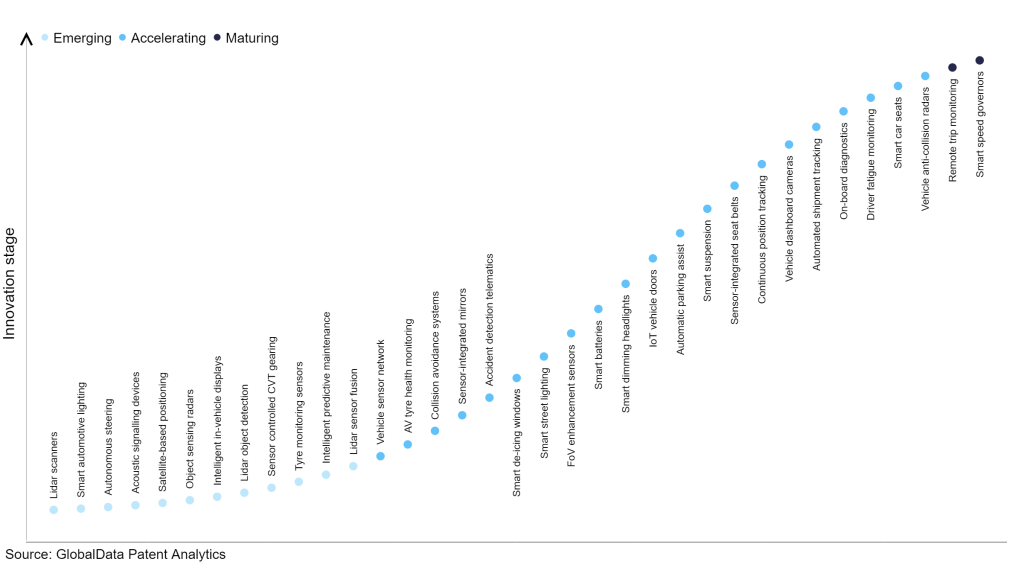The automotive industry continues to be a hotbed of patent innovation. Activity in sensor controlled continuously variable transmission (CVT) gearing is driven by engine optimization, environmental regulations, fuel efficiency, and emissions reduction, and growing importance of technologies such as accelerometers, torque sensors, and transmission range sensors. In the last three years alone, there have been over 1.7 million patents filed and granted in the automotive industry, according to GlobalData’s report on Internet of Things in automotive: sensor controlled CVT gearing. Buy the report here.
However, not all innovations are equal and nor do they follow a constant upward trend. Instead, their evolution takes the form of an S-shaped curve that reflects their typical lifecycle from early emergence to accelerating adoption, before finally stabilizing and reaching maturity.
Identifying where a particular innovation is on this journey, especially those that are in the emerging and accelerating stages, is essential for understanding their current level of adoption and the likely future trajectory and impact they will have.
300+ innovations will shape the automotive industry
According to GlobalData’s Technology Foresights, which plots the S-curve for the automotive industry using innovation intensity models built on over one million patents, there are 300+ innovation areas that will shape the future of the industry.
Within the emerging innovation stage, LiDAR scanners, smart automotive lighting, and autonomous steering are disruptive technologies that are in the early stages of application and should be tracked closely. Vehicle sensor network, AV tire health monitoring, and collision avoidance systems are some of the accelerating innovation areas, where adoption has been steadily increasing. Among the maturing innovation areas are remote trip monitoring and smart speed governors, which are now well established in the industry.
Innovation S-curve for Internet of Things in the automotive industry

Sensor controlled CVT gearing is a key innovation area in Internet of Things
Sensor controlled CVT gearing refers to a continuously variable transmission (CVT) that uses sensor technology to regulate its gearing under various driving conditions. The transmission contains a variator unit, a planetary gear unit, and an input and output shaft. The sensor feedback helps to optimize the transmission's efficiency and performance.
GlobalData’s analysis also uncovers the companies at the forefront of each innovation area and assesses the potential reach and impact of their patenting activity across different applications and geographies. According to GlobalData, there are 20+ companies, spanning technology vend ors, established automotive companies, and up-and-coming start-ups engaged in the development and application of sensor controlled CVT gearing.
Key players in sensor controlled CVT gearing – a disruptive innovation in the automotive industry
‘Application diversity’ measures the number of applications identified for each patent. It broadly splits companies into either ‘niche’ or ‘diversified’ innovators.
‘Geographic reach’ refers to the number of countries each patent is registered in. It reflects the breadth of geographic application intended, ranging from ‘global’ to ‘local’.
Patent volumes related to sensor controlled CVT gearing
Source: GlobalData Patent Analytics
Nissan Motor is one of the leading patent filers in sensor controlled CVT gearing. The company’s predictive shift control system utilizes advanced algorithms and predictive analytics to anticipate driving conditions, allowing the CVT to proactively adjust gear ratios for optimal performance. Some other key patent filers in this space include Kubota and Zeppelin-Stiftung.
In terms of application diversity, Toyota Motor leads the pack, while Komatsu and General Motors stood in the second and third positions, respectively. By means of geographic reach, Nissan Motor held the top position, followed by Liebherr and Toyota Motor.
To further understand the key themes and technologies disrupting the automotive industry, access GlobalData’s latest thematic research report on Internet of Things (IoT) in Automotive.
Premium Insights
From

The gold standard of business intelligence.
Blending expert knowledge with cutting-edge technology, GlobalData’s unrivalled proprietary data will enable you to decode what’s happening in your market. You can make better informed decisions and gain a future-proof advantage over your competitors.



